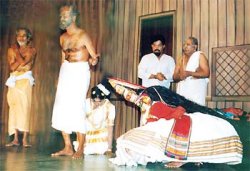 |
 |
CHOLLIYATTOM by C.P. Unnikrishnan, Kochi e-mail: bharathamuni@satyam.net.in October, 2001 |
| “So long as I am alive, I cannot accept Kathakali as just a play without its soul; I shall show you what Kathakali is”. With these words of authority, Kesava Panicker asan went into action and fell dead in front of the deserving witnesses – his son Kuttan who has been trying to sell Kathakali and Mohiniyattom to the non-Indian tourist. Among the witnesses were, Panicker’s right hand man Sankaran Nair, daughter Karthu and the Chenda artist Kuttappa Marar. This--------- the last scene of the Malayalam play ‘Cholliyattom’ ends with the announcement that Panicker has been posthumously awarded ‘Natyavibhooshan’ for his inimitable contributions to Kathakali. |  |
| A
trust was also formed to collect rupees fifty lacks to construct a monument
in the name of the departed doyen. His son Kuttan, the made up encyclopedia
of Kerala-arts, and Unni Namboothiri a great patron of Kathakali, were
elected as the life long managing trustees of the ‘Kesava Panicker Memorial
trust’. As Kuttan & Namboothiri stand in silence under the shower
light, the play ends exposing the masked hypocrisy of the society.
‘Cholliyattom’ - the technical term for playing to the vocal rendering of songs in Kathakali-, a play written and directed by K. Balasubrahmanyan was staged on 20.10.2001, at the Platinum Jubilee Memorial Hall of the Ernakulam Karayogam, Cochin, on the fourth day of the ten day long Navarathri celebrations. The elite audience whole-heartedly appreciated the play, despite few of the initial ancillary disturbances. The theme is centered on the exposition of the hardships a committed artist goes through. If the result of the untiring crusade shatters against the cruelly sharp, inert, glacier of social pseudo-patronage and hypocrisy, the commander has to sink with the ship. Alas! Kesava Panicker was no exception to this rule. The two hour long play began with the ‘Aniyara’, the makeup & costume room, a scene, which many of the general audience would not have seen. All the informal and formal incidents in the ‘Aniyara’ were revealed in a realistic ambience. The process of Panicker removing his costumes, some characters with half done makeup & costumes were on the stage as the curtain opened; many thought, the curtain went up by mistake – that was the beginning of the first scene. The scene ended with an off scene note that Panicker’s wife died while watching the performance. The second scene exposed the impertinence of Panicker’s son Kuttan and the down to earth commitment of Panicker’s favourite disciple Naanu. The third scene demonstrated the realistic Cholliyattom, where Naanu’s mind slipped as he noticed his teacher’s daughter Karthu admiring his training session. Naanu misinterpreted ‘Veera rasa’ as ‘Sringara’. The uncompromising maestro, who hit Naanu, found to his dismay, his disciple’s eye badly hurt & bleeding. Without informing Panicker, his dearest disciple left for Bombay, with his brother. This marked the second tragic incident, that put Panicker off his mental balance- an episode that revealed the mind of a true loving yet rigid teacher; THE GURU. A year passed by as the fourth scene, through the conversations among Sreedi Antharjanam, Marar and Karthu narrated the social changes and the pathetic plight of the bed ridden Panicker. Unni Namboothiri who patronised a whole performing group, shifted to the urban sectors to sell Kathakali and make money. Kuttan became the tourists’ first hand info-guide to Kathakali Marar; the Chenda exponent became debilitated and poor. Only Sankaran Nair and Karthu, with their suppressed grief, continued to nurse Panicker who frequently went through transient amnesia. The scene ended with the touching incident in quick and soft dialogues. Nanu who returned from Bombay as a modernised young man, wanted to recall and reinstate everything, which Karthu denied. They departed; a frame that made a few in the audience wipe their tears. Scene five brought in full gravity the psychic turbulence in the weakened maestro. Panicker admitted in consciousness, his failure as a father. The scene finale brought out the comic looking yet heart breaking sale deed between Kuttan and a non-Indian tourist. Karthu who has never danced, was made to stand in the guise of a Mohiniyattom danseuse, the costume assistant had to present himself as a Kathakali artist; all unwillingly supported by Sankaran Nair. The beats on the Chenda brought the mentally deranged Keshava Panicker, where his own son was synthesizing commercial Drama, mutilating the soul and heart of Kathakali and Mohiniyattom. Unable to withstand the damage done to his dearest art Panicker gave himself up for ever……..! The playwright and director who handled Kesava Panicker asan revealed the artist in him, monitoring the transient phases with ease. R.L. V. Radhakrishnan, one of the top-rated Kathakali artists, as Nanu, ensured the audience that to deliver dialogues without hand gestures is a job quite secure in his hands. C.S. Menon as Sankaran Nair, an experienced theatre expert could make the air wet, with tears; such was his involvement in handling the character’s stage business. The accepted humourist, R. Viswam as Marar could tickle the audience who occasionally burst into intelligent laughter. Ambili as Karthu, Usha Devarajan as Sreedevi Antharjanam, U.K. Menon as Unni Namboothiri Kalanilayam Rajeev as the Kathakali singer, K.R. Gopalakrishnan as the foreigner, Nandakumar as Govindan, P. Surendran as Kuttan completed the cast-format, befitting physique and action. Mohan on the
Sitar, Subrahmanyan Namboothiri on the Chenda provided the supporting music.
Chittur Radhakrishna Pisharoti, Cherthala Kumaran and Manoj Eroor, shaped
the characters from the green room.
|
| C P Unnikrishnan is a Kochi based Kathakali actor, critic and research scholar engaged at present in tracing the interlinks among the art forms of Kerala based on Bharatha's Natyasasthra. |  |